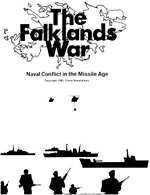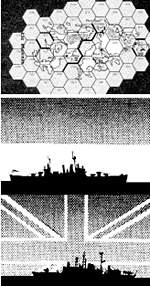 Introduction
Introduction
The Falklands War Naval Conflict in the Missile Age
Publisher: Close Simulations
Designer: Wayne C. Close, Capt. USAFR
First (and only) edition, 1982 “The Falklands War is a two player simulation of the conflict fought over the islands of the same name. Play starts on the 1st of May, 1982 and ends by either a diplomatic resolution of the crisis or the defeat of one side by the other. The game is played in a series of game turns in which players alternate moves and combat according to the Sequence of Play ... Victory is determined by victory points awarded for destroying enemy units and capturing military objectives. Each hexagon (hex) on the map represents 20 nautical miles. Each platoon represents about 200 men, companies about 500, battalions about 1100 and regiments and brigades 3500. Each aircraft unit represents a squadron of 12 aircraft, half units a flight of six.
The three exceptions to this are the Argentine KC-130 (two aircraft), C-130 (nine aircraft) and the Super Etendard (five aircraft). Each sea unit represents a single vessel. Each game turn is equal to two days of real time.”
Components
One bookcase box, 9”x11.5”x2”. Box lid cover has silhouette of troops in fore-ground (bottom-most quarter), silhouette of ships over a medium mustard-yellow sea background (second quarter from bottom), silhouette of helicopters over a light mustard-yellow sky background (third quarter from bottom), and the game name superimposed over a line-art map of the Falklands (top-most quarter). The box bottom in the review copy was blank - not sure if this is how the game was shipped or if this is a replacement bottom.
One 23.75”x22” hex map. The Falkland Islands are (roughly) in the center of the map, the South Atlantic dominates the map, and the Argentine coast from Comodoro Rivadavia in the north to (approximately) Ushuaia in the south, runs along the Western edge. The map has various charts, tracks, and holding areas along three sides, so the actual play area is closer to 19.5”x16 to 19”. 238 2-sided die-cut counters One black & white rule book, 8.5”x11” (12 pages of text, printed front cover, blank back and inner covers, for a total of 16 pages).
Two single-sided black &white player-aid cards, 8.5”x11” (one with three CRTs and a repair/construction table; the other with terrain key and list of ships by type). Two six-sided dice Two ziplock bags (4.25”x4.5”) One single page, single-sided 8.5”x11”
 The Falklands War Update Kit consisting of OOB and counter changes and additions, plus a few errata. Along the bottom of the sheet, printed in black on red, are counters (fronts and backs) for 15 replacement or additional British vessels (these are to be cut out and glued to cardboard). One four-page The Falklands War Errata dated 6 April 1984, which requires the Update Kit sheet. Includes extensive OOB and setup changes and additions; rules changes, additions and clarifications, and a half page off-map display to cut down on counter clutter.
The Falklands War Update Kit consisting of OOB and counter changes and additions, plus a few errata. Along the bottom of the sheet, printed in black on red, are counters (fronts and backs) for 15 replacement or additional British vessels (these are to be cut out and glued to cardboard). One four-page The Falklands War Errata dated 6 April 1984, which requires the Update Kit sheet. Includes extensive OOB and setup changes and additions; rules changes, additions and clarifications, and a half page off-map display to cut down on counter clutter.
Player’s Value
Like the actual conflict itself, The Falklands War crams the breadth of warfare, from strategic down to tactical, into one package. The strategic levels are touched on only lightly via the inclusion of a diplomacy track and its restrictions on British actions (and the end of the game). That still leaves operational and tactical, which the game tries to do both of, with mixed success. The map is essentially operational in scale, with the islands themselves only occupying a handful of hexes in the middle of a sea of blue (as compared to Port Stanley, which focuses on the tactical battle and has a map dominated by the islands).
As you might expect, this can make for a very dense land battle, especially if units are broken down to the company and platoon scale. Surprisingly, even the sea battle can get unwieldy in a purely physical sense -- stacks can grow to towering heights, what with ships transporting multiple land and air units sitting under aircraft in the sky conducting attacks, escorting attackers, and/or intercepting attackers and escorts. It’s no wonder the errata dated 6 April 1984 included an off-map display to help reduce this clutter.
Still, you do get an appreciation of the operational issues that you don’t get in a purely tactical game -- after all, a large, significant part of the war occurred before the British ever landed, and The Falklands War helps portray this.
Surprisingly (for a naval game) there’s really no mechanism for hidden movement (aside from some rules in the errata for hidden sub movement) -- all naval movement is out in the open, thus ignoring a big part of the conflict (the question of where the fleets and air forces were). To some extent this is off-set by the order of movement, but not completely. Also, it’s quite hard for the Argentine player to bring the British player to grips, as he always moves first (the British player can always move out of harm’s way, at least when threatened by platforms of a similar type). Then again, this does represent the United Kingdom’s higher-quality forces.
When a game has about ten and a half pages of rules and nearly five pages of errata, you get the feeling that it may have been rushed a tad. The order of battle, particularly for British ships, is way off, and if you get a copy of the game that was marked up according to the errata you’ll have a very marked up game indeed. The ship counters don’t have an indicator of their type (CV, CA, DD, etc.), so unless you’ve memorized the respective countries’ fleets for this period, you’ll have to rely on the confusing and inaccurate ship list on one of the data cards or your ability to differentiate the silhouettes on the counters, silhouettes which aren’t necessarily to scale compared to one another.
All in all, The Falklands War is an okay game that is rather hindered by its apparently rushed production (it came out not that long after the war) and by some congested play and/or awkward mechanics.
Collector’s Value
All games about the Falklands war are relatively rare. Of them all, only Port Stanley from Wargamer 28 seems to put in an appearance once in while. For those interested in this conflict, this makes The Falklands War quite a find, but note that caveat: for those interested. You likely won’t find the interest level of the general wargaming public nearly as high for this game as for, say, a copy of Atlantic Wall or War in Europe. Boone lists low, high and average values of 3/7/5.25 at auction and 3/40/16.00 for sale.
Support Material
Wargamer 28 (Port Stanley), page 17 (Close Simulations advertisement for the game, which contains quotes from reviews in The Journal of 20th Century Wargaming and Fire & Movement.) The Journal of 20th Century Wargaming Issue XIII contains a substantive review, including a history of the war and a bibliography. Fire & Movement 38 contains a short but positive review (Player’s Notes).
Other Games of This Type
Operation Goose Green: Malvinas 1982 (Alea 17); Resolution 502 (Adventure); Port Stanley (3W); War in the South Atlantic (Citadel); Falklands or Malvinas (Lightfoot & Assoc.); Falkland Sound & War in the Falklands (Mayfair); Harpoon scenarios.
Other Games by This Designer
Custer’s Luck (Wargamer 45); Alert Force; Check Six; Hovertank & Mission Grenada (all Close Simulations).
The Falklands Wars Counter Manifest
Back to Simulacrum Vol. 2 No. 3 Table of Contents
Back to Simulacrum List of Issues
Back to MagWeb Master Magazine List
© Copyright 2000 by Steambubble Graphics
This article appears in MagWeb (Magazine Web) on the Internet World Wide Web. Other military history articles and gaming articles are available at http://www.magweb.com